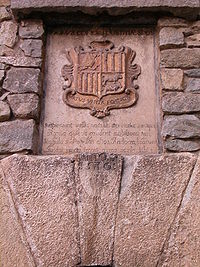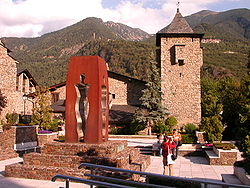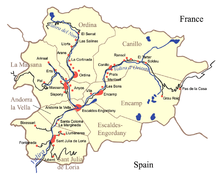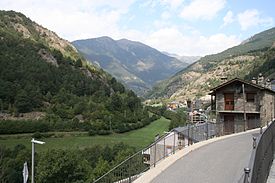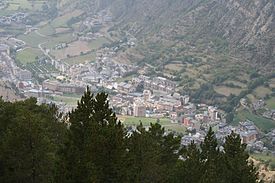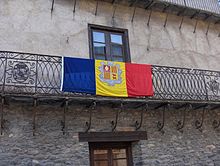- Andorra
-
Principality of Andorra Principat d'Andorra

Flag Coat of arms Motto: "Virtus Unita Fortior" (Latin)
"Strength United is Stronger"Anthem: El Gran Carlemany, Mon Pare (Catalan)
The Great Charlemagne, my FatherLocation of Andorra (green)in Europe (dark grey) — [Legend]
Capital
(and largest city)Andorra la Vella
42°30′N 1°31′E / 42.5°N 1.517°EOfficial language(s) Catalan[1]3 Ethnic groups 36.6% Andorran, 33.0% Spanish, 16.3% Portuguese, 6.3% French, 7.8% others.[2] Demonym Andorran Government Unitary parliamentary democracy and Constitutional diarchy - Co-Princes Joan Enric Vives Sicília
Nicolas Sarkozy- Representatives Nemesi Marqués Oste
Christian Frémont- Prime Minister Antoni Martí Independence - Paréage from the Crown of Aragon
1278Area - Total 467.63 km2 (191st)
180.55 sq mi- Water (%) 0.26 (121.4 ha)[3][4] Population - 31 December 2009 estimate 84,082[5] (194th) - 2006 census 69,150 - Density 179.8/km2 (69th)
465.7/sq miGDP (PPP) 2008 estimate - Total $4.22 billion (155th) - Per capita $44,900 (9th) GDP (nominal) 2008 estimate - Total $2.893 billion[6] (155th) - Per capita $34,240[6] (28th) Gini (2003) 27.21[7] HDI (2011)  0.838[8] (very high) (32nd)
0.838[8] (very high) (32nd)Currency Euro (€)1 ( EUR)Time zone CET (UTC+1) - Summer (DST) CEST (UTC+2) Drives on the right ISO 3166 code AD Internet TLD .ad2 Calling code +376 1 Before 1999, the French franc and Spanish peseta; the coins and notes of both currencies, however, remained legal tender until 2002. Small amounts of Andorran diners (divided into 100 centim) were minted after 1982. 2 Also .cat, shared with Catalan-speaking territories. 3 Spanish, French, and Portuguese are also widely spoken and understood. (See Languages of Andorra) Andorra
 i/ænˈdɔrə/ (Catalan pronunciation: [ənˈdorə], locally: [anˈdɔra]), officially the Principality of Andorra (Catalan: Principat d'Andorra), also called the Principality of the Valleys of Andorra,[9] (Catalan: Principat de les Valls d'Andorra), is a small landlocked country in southwestern Europe, located in the eastern Pyrenees mountains and bordered by Spain and France. It is the sixth smallest nation in Europe having an area of 468 km2 (181 sq mi) and an estimated population of 84,082 in 2009. Its capital, Andorra la Vella, is the highest capital city in Europe, being at an elevation of 1023 metres.[10] The official language is Catalan, although Spanish, Portuguese, and French are also commonly spoken.
i/ænˈdɔrə/ (Catalan pronunciation: [ənˈdorə], locally: [anˈdɔra]), officially the Principality of Andorra (Catalan: Principat d'Andorra), also called the Principality of the Valleys of Andorra,[9] (Catalan: Principat de les Valls d'Andorra), is a small landlocked country in southwestern Europe, located in the eastern Pyrenees mountains and bordered by Spain and France. It is the sixth smallest nation in Europe having an area of 468 km2 (181 sq mi) and an estimated population of 84,082 in 2009. Its capital, Andorra la Vella, is the highest capital city in Europe, being at an elevation of 1023 metres.[10] The official language is Catalan, although Spanish, Portuguese, and French are also commonly spoken.The Principality was formed in 1278. The role of monarch is exercised jointly by the two co-princes, the President of the French Republic and the Bishop of Urgell, Catalonia.
Andorra is a prosperous country mainly because of its tourism industry, which services an estimated 10.2 million visitors annually,[11] and also because of its status as a tax haven. It is not a member of the European Union, but the euro is the de facto currency. The people of Andorra have the 4th highest human life expectancy in the world — 82 years at birth.[12]
Contents
History
Tradition holds that Charles the Great (Charlemagne) granted a charter to the Andorran people in return for fighting against the Moors. Overlordship of the territory was by the Count of Urgell and eventually by the bishop of the Diocese of Urgell. In 988, Borrell II, Count of Urgell, gave the Andorran valleys to the Diocese of Urgell in exchange for land in Cerdanya.[13] Since then the Bishop of Urgell, based in Seu d'Urgell, has owned Andorra.[14]
Before 1095, Andorra did not have any type of military protection and the Bishop of Urgell, who knew that the Count of Urgell wanted to reclaim the Andorran valleys,[14] asked for help and protection from the Lord of Caboet. In 1095, the Lord of Caboet and the Bishop of Urgell signed under oath a declaration of their co-sovereignty over Andorra. Arnalda, daughter of Arnau of Caboet, married the Viscount of Castellbò and both became Viscounts of Castellbò and Cerdanya. Years later their daughter, Ermessenda,[15] married Roger Bernat II, the French Count of Foix. They became Roger Bernat II and Ermessenda I, Counts of Foix, Viscounts of Castellbò and Cerdanya, and also co-sovereigns of Andorra (shared with the Bishop of Urgell).
In the 11th century, a dispute arose between the Bishop of Urgell and the Count of Foix. The conflict was resolved in 1278 with the mediation of Aragon by the signing of the first paréage which provided that Andorra's sovereignty be shared between the count of Foix[14] (whose title would ultimately transfer to the French head of state) and the Bishop of Urgell, in Catalonia. This gave the principality its territory and political form.
Over the years, the French co-title to Andorra passed to the kings of Navarre. After Henry of Navarre became King Henry IV of France, he issued an edict in 1607 that established the head of the French state and the Bishop of Urgell as co-princes of Andorra. In 1812–13, the First French Empire annexed Catalonia and divided it in four départements, with Andorra being made part of the district of Puigcerdà (département of Sègre).
20th century
Andorra declared war on Imperial Germany during World War I, but did not actually take part in the fighting. It remained in an official state of belligerency until 1957 as it was not included in the Treaty of Versailles.
In 1933, France occupied Andorra as a result of social unrest before elections. On July 12, 1934, adventurer Boris Skossyreff issued a proclamation in Urgell, declaring himself "Boris I, King of Andorra", simultaneously declaring war on the Bishop of Urgell. He was arrested by Spanish authorities on July 20 and ultimately expelled from Spain. From 1936 to 1940, a French detachment was garrisoned in Andorra to prevent influences of the Spanish Civil War and Franco's Spain. Francoist troops reached the Andorran border in the later stages of the war. During World War II, Andorra remained neutral and was an important smuggling route between Vichy France and Spain.
Given its relative isolation, Andorra has existed outside the mainstream of European history, with few ties to countries other than France and Spain. In recent times, however, its thriving tourist industry along with developments in transport and communications have removed the country from its isolation. Its political system was modernised in 1993, when it became a member of the United Nations and the Council of Europe.
Politics
Andorra is a parliamentary co-principality with the President of France and the Bishop of Urgell (Catalonia, Spain), as co-princes. This peculiarity makes the President of France, in his capacity as Prince of Andorra, an elected reigning monarch, even though he is not elected by a popular vote of the Andorran people. The politics of Andorra take place in a framework of a parliamentary representative democracy, whereby the Prime Minister of Andorra is the head of government, and of a pluriform multi-party system.
The current Prime Minister is Antoni Martí of the Democrats for Andorra (DA). Executive power is exercised by the government. Legislative power is vested in both government and parliament.
The Parliament of Andorra is known as the General Council. The General Council consists of between 28 and 42 Councilors, as the members of the legislative branch are called. The Councilors serve for four-year terms and elections are held between the thirtieth and fortieth days following the dissolution of the previous Council. The Councilors can be elected on two equal constituencies.
Half are elected in equal number from each of the seven administrative parishes and the other half of the Councilors are elected from a single national constituency. 15 days after the election, the Councilors hold their inauguration. During this session, the Syndic General, who is the head of the General Council, and the Subsyndic General, his assistant, are elected. Eight days later, the Council convenes once more. During this session the Head of Government, the Prime Minister of Andorra, is chosen from among the Councilors.
Candidates for the prime-ministerial nomination can be proposed by a minimum of one-fifth of the Councilors. The Council then elects the candidate with the absolute majority of votes to be Head of Government. The Syndic General then notifies the Co-princes who in turn appoint the elected candidate as the Prime Minister of Andorra. The General Council is also responsible for proposing and passing laws. Bills may be presented to the Council as Private Members' Bills by three of the Local Parish Councils jointly or by at least one tenth of the citizens of Andorra.
The Council also approves the annual budget of the principality. The government must submit the proposed budget for parliamentary approval at least two months before the previous budget expires. If the budget is not approved by the first day of the next year, the previous budget is extended until a new one is approved. Once any bill is approved, the Syndic General is responsible for presenting it to the Co-princes so that they may sign and enact it.
If the Head of Government is not satisfied with the Council, he may request that the Co-princes dissolve the Council and order new elections. In turn, the Councilors have the power to remove the Head of Government from office. After a motion of censure is approved by at least one-fifth of the Councilors, the Council will vote and if it receives the absolute majority of votes, the Prime Minister is removed.
Law and criminal justice
The judiciary is composed of the Magistrates Court, the Criminal Law Court, the High Court of Andorra, and the Constitutional Court. The High Court of Justice is composed of five judges: one appointed by the Head of Government, one each by the Coprinces, one by the Syndic General, and one by the Judges and Magistrates. It is presided over by the member appointed by the Syndic General and the judges hold office for six-year terms.
The Magistrates and Judges are appointed by the High Court, and so is the President of the Criminal Law Court. The High Court also appoints members of the Office of the Attorney General. The Constitutional Court is responsible for interpreting the Constitution and reviewing all appeals of unconstitutionality against laws and treaties. It is composed of four judges, one appointed by each of the Coprinces and two by the General Council. They serve eight-year terms. The Court is presided over by one of the Judges on a two-year rotation so that each judge at one point will be the leader of the Court.
Foreign relations and defence
Andorra maintains a small Army, and all able-bodied men who own firearms must serve. The Army is unique in that all men are treated as officers. The Army's main responsibility is to present the national flag at ceremonies. The country also has an internal police force. Responsibility for defending Andorra rests primarily with France and Spain. Andorra is a full member of the United Nations, the OSCE, and has a special agreement with the European Union.
Geography
Parishes
Andorra consists of seven parishes:
Physical geography
Due to its location in the eastern Pyrenees mountain range, Andorra consists predominantly of rugged mountains, the highest being the Coma Pedrosa at 2,942 metres (9,652 ft), and the average elevation of Andorra is 1,996 metres (6,549 ft).[16] These are dissected by three narrow valleys in a Y shape that combine into one as the main stream, the Gran Valira river, leaves the country for Spain (at Andorra's lowest point of 840 m/2,756 ft). Andorra's land area is 468 km2 (181 sq mi).
Phytogeographically, Andorra belongs to the Atlantic European province of the Circumboreal Region within the Boreal Kingdom. According to the WWF, the territory of Andorra belongs to the ecoregion of Pyrenees conifer and mixed forests.
Climate
Andorra has an alpine climate and continental climate. Its higher elevation means there is, on average, more snow in winter, lower humidity, and it is slightly cooler in summer. There are, on average, 300 days per year of sunshine.
Economy
 Caldea spa in Escaldes-Engordany, heated by natural hot spring water which is plentiful in the parish.
Caldea spa in Escaldes-Engordany, heated by natural hot spring water which is plentiful in the parish.
Tourism, the mainstay of Andorra's tiny, well-to-do economy, accounts for roughly 80% of GDP. An estimated 10.2 million tourists visit annually,[11] attracted by Andorra's duty-free status and by its summer and winter resorts. Andorra's relative advantage has recently eroded as the economies of adjoining France and Spain have been opened up, providing broader availability of goods and lower tariffs.
The banking sector, with its tax haven status, also contributes substantially to the economy. Agricultural production is limited—only 2% of the land is arable—and most food has to be imported. Some tobacco is grown locally. The principal livestock activity is domestic sheep raising. Manufacturing output consists mainly of cigarettes, cigars, and furniture. Andorra's natural resources include hydroelectric power, mineral water, timber, iron ore, and lead.[17]
Andorra is not a member of the European Union, but enjoys a special relationship with it, such as being treated as an EU member for trade in manufactured goods (no tariffs) and as a non-EU member for agricultural products. Andorra lacked a currency of its own and used both the French franc and the Spanish peseta in banking transactions until 31 December 1999, when both currencies were replaced by the EU's single currency, the euro. Coins and notes of both the franc and the peseta remained legal tender in Andorra until 31 December 2002. Andorra is negotiating to issue its own euro coins.
Andorra has one of the world's lowest unemployment rates, with the statistics on June 2009 showing almost 0% unemployment within the country.[citation needed]
Demography
Population
The population of Andorra is estimated to be 83,888 (July 2009).[18] The population has grown from 5,000 in 1900.
Andorran nationals are a plurality in the country (31,363);[19] other nationalities include Spaniards (27,300),[19] Portuguese (13,794),[19] French (5,213),[19] Britons (1,085)[19] and Italians.
Languages
The historic and official language is Catalan, a Romance language. The Andorran government is keen to encourage the use of Catalan. It funds a commission for Catalan toponymy in Andorra (Catalan: la Comissió de Toponímia d'Andorra), and provides free Catalan classes to assist immigrants. Andorran television and radio stations use Catalan.
Because of immigration, historical links, and close geographic proximity, Spanish, Portuguese and French are also commonly spoken. Most Andorran residents can speak one or more of these, in addition to Catalan. English is less commonly spoken among the general population, though it is understood to varying degrees in the major tourist resorts. Andorra is one of only three European countries (together with France and Monaco)[20] that have never signed the Council of Europe Framework Convention on National Minorities.[21]
Religion
The population of Andorra is predominantly (90%) Roman Catholic.[22] Their patron saint is Our Lady of Meritxell. Though it is not an official state religion, the constitution acknowledges a special relationship with the Catholic Church, offering some special privileges to that group. The Muslim community is primarily made up of North African immigrants. Other Christian denominations include the Anglican Church, the Reunification Church, the New Apostolic Church, The Church of Jesus Christ of Latter-day Saints, and the Jehovah’s Witnesses. There is a small community of Hindus and Bahá'ís.[23][24] Andorra also hosts a population of roughly 100 Jews (see: Andorran Jews).
Education
Schools
Children between the ages of 6 and 16 are required by law to have full-time education. Education up to secondary level is provided free of charge by the government.
There are three systems of schools – Andorran, French and Spanish – which use Catalan, French and Spanish, respectively, as the main language of instruction. Parents may choose which system their children attend. All schools are built and maintained by Andorran authorities, but teachers in the French and Spanish schools are paid for the most part by France and Spain. About 50% of Andorran children attend the French primary schools, and the rest attend Spanish or Andorran schools.
University of Andorra
The University of Andorra (UdA) is the state public university and is the only university in Andorra. It was established in 1997. The University provides first-level degrees in nursing, computer science, business administration, and educational sciences, in addition to higher professional education courses. The only two graduate schools in Andorra are the Nursing School and the School of Computer Science, the latter having a PhD program.
Virtual Studies Centre
The geographical complexity of the country as well as the small number of students prevents the University of Andorra from developing a full academic program, and it serves principally as a centre for virtual studies, connected to Spanish and French universities. The Virtual Studies Centre (Centre d’Estudis Virtuals) at the University runs in the region of twenty degrees at both undergraduate and postgraduate levels in fields including tourism, law, Catalan philology, humanities, psychology, political sciences, audiovisual communication, telecommunications engineering, and East Asia studies. The Centre also runs various postgraduate programs and continuing-education courses for professionals.
Healthcare
Healthcare in Andorra is provided to all employed persons and their families by the government-run social security system, CASS (Caixa Andorrana de Seguretat Social), which is funded by employer and employee contributions in respect of salaries.[25] The cost of healthcare is covered by CASS at rates of 75% for out-patient expenses such as medicines and hospital visits, 90% for hospitalisation, and 100% for work-related accidents. The remainder of the costs may be covered by private health insurance. Other residents and tourists require full private health insurance.[25]
The main hospital, Meritxell, is in Escaldes-Engordany.[26] There are also 12 primary health care centres in various locations around the Principality.[26]
Transport
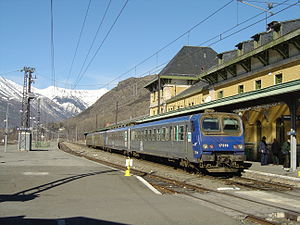 A train at Latour-de-Carol, one of the two stations serving Andorra. Andorra has no railways, although the line connecting Latour-de-Carol and Toulouse, which in turn connects to France's TGVs at Toulouse, runs within two kilometres of the Andorran border.
A train at Latour-de-Carol, one of the two stations serving Andorra. Andorra has no railways, although the line connecting Latour-de-Carol and Toulouse, which in turn connects to France's TGVs at Toulouse, runs within two kilometres of the Andorran border.
Until the 20th century, Andorra had very limited transport links to the outside world, and development of the country was affected by its physical isolation. Even now, the nearest major airports at Toulouse and Barcelona are both three hours' drive from Andorra.
Andorra has a road network of 279 km (173 mi), of which 76 km (47 mi) is unpaved. The two main roads out of Andorra la Vella are the CG-1 to the Spanish border, and the CG-2 to the French border via the Envalira Tunnel near Pas de la Casa.[27] Bus services cover all metropolitan areas and many rural communities, with services on most major routes running half-hourly or more frequently during peak travel times. There are frequent long-distance bus services from Andorra to Barcelona and Toulouse. Bus services are mostly run by private companies, but some local ones are operated by the government.
There are no railways, ports, or airports for fixed-wing aircraft in Andorra. There are, however, heliports in La Massana, Arinsal and Escaldes-Engordany with commercial helicopter services.[28][29] Nearby airports are located in Barcelona, Toulouse, Perpignan, Reus, and Girona. The closest public airport is Perpignan - Rivesaltes Airport, which is 160 km (99 mi) away and has short-haul services to several destinations in the United Kingdom and France. La Seu d'Urgell Airport, a small airfield 12 km (7 mi) south of Andorra currently used only by private aeroplanes, is being studied by the Catalan government as a possible future airport for public aviation services.[30]
The nearest railway station is L'Hospitalet-près-l'Andorre 10 km (6 mi) east of Andorra which is on the 1,435 mm (4 ft 8 1⁄2 in)-gauge line from Latour-de-Carol, (25 km/16 mi) southeast of Andorra, to Toulouse and on to Paris by the French high-speed trains. This line is operated by the SNCF. Latour-de-Carol has a scenic metre gauge trainline to Villefranche-de-Conflent, as well as the SNCF's 1,435 mm (4 ft 8 1⁄2 in)-gauge line connecting to Perpignan, and the RENFE's 1,668 mm (5 ft 5 2⁄3 in) -gauge line to Barcelona.[31][32]
Media and telecommunications
In Andorra, mobile and fixed telephone and internet services are operated exclusively by the Andorran national telecommunications company, SOM, also known as Servei de Telecomunicacions d'Andorra (STA). The same company also manages the technical infrastructure for national broadcasting of digital television and radio.
By the end of 2010, it is planned that every home in the country will have fibre-optic to the home for internet access at a minimum speed of 100 Mbit/s.[33]
There is only one Andorran television station, Ràdio i Televisió d'Andorra (RTVA). Radio Nacional d’Andorra operates two radio stations, Radio Andorra and Andorra Música. There are three national newspapers, Diari d'Andorra, El Periòdic d'Andorra, and Bondia as well as several local newspapers.
Culture
The official and historic language is Catalan. Thus the culture is Catalan, with its own specificity.
Andorra is home to folk dances like the contrapàs and marratxa, which survive in Sant Julià de Lòria especially. Andorran folk music has similarities to the music of its neighbours, but is especially Catalan in character, especially in the presence of dances such as the sardana. Other Andorran folk dances include contrapàs in Andorra la Vella and Saint Anne's dance in Escaldes-Engordany. Andorra's national holiday is Our Lady of Meritxell Day, September 8.[17] American Folk Artist Malvina Reynolds, intrigued by its defense budget of $4.90, wrote a song "Andorra". Pete Seeger added verses, and sang "Andorra" on his 1962 album "The Bitter and the Sweet.".
Sports
Andorra is famous by the practice of Winter Sports and also by Roller Hockey. Andorra usually plays in CERH Euro Cup and in FIRS Roller Hockey World Cup. In 2011, Andorra will be the host country to the 2011 European League Final Eight. The country is represented in association football by the Andorra national football team. However, the team has had little success internationally due to Andorra's small population.[34]
See also
- Outline of Andorra
- Bibliography of Andorra
- Index of Andorra-related articles
- Andorra and the European Union
- Communications in Andorra
- European microstates
- Foreign relations of Andorra
References
- ^ Constitution of Andorra (Article 2.1)
- ^ Estadísticas de población de Andorra. Ministerio de Justicia e Interior de Andorra
- ^ Girard P & Gomez P (2009), Lacs des Pyrénées: Andorre. (French)
- ^ Andorra en xifres 2007: Situació geogràfica, Departament d'Estadística, Govern d'Andorra. Retrieved on 6 June 2010.
- ^ Dades de població any 2009: 1- Població per parròquies al 31 de desembre del 2009, Departament d'Estadística, Govern d'Andorra. Retrieved on 6 June 2010.
- ^ a b Andorra 2008, Crèdit Andorrà.
- ^ Estadistica.ad
- ^ "Human Development Report 2010". United Nations. 2010. http://hdr.undp.org/en/media/HDR_2010_EN_Table1.pdf. Retrieved 5 November 2010.
- ^ Funk and Wagnalls Encyclopedia, 1991
- ^ Maps, Weather, and Airports for Andorra la Vella, Andorra
- ^ a b Estadistica.ad, Departament d'Estadística, Govern d'Andorra. (Catalan)
- ^ Pat Thompson (23 April 2009). "Why Andorrans live longer than everyone else". CNN. http://www.cnn.com/2009/HEALTH/04/23/andorra.life.expectancy/index.html. Retrieved 7 June 2009.
- ^ "La formació d'Andorra". l’Enciclopèdia. Enciclopèdia Catalana. http://www.enciclopedia.cat/fitxa_v2.jsp?NDCHEC=0003864. (Catalan) English version
- ^ a b c "Elements de la història del Principat d'Andorra" (in Catalan). Archived from the original on 2010-02-09. http://web.archive.org/web/20100209181327/http://www.coprince-fr.ad/catala/elements.htm.
- ^ "Ermessenda de Castellbò". l’Enciclopèdia. Enciclopèdia Catalana. http://www.enciclopedia.cat/fitxa_v2.jsp?NDCHEC=0024413. (Catalan) English version
- ^ Atlas of Andorra (1991), Andorran Government. ISBN 0099913910391. (Catalan)
- ^ a b "CIA World Factbook entry: Andorra". https://www.cia.gov/library/publications/the-world-factbook/geos/an.html.
- ^ CIA World Factbook (2009)
- ^ a b c d e Departament d'Estadistica, 2008
- ^ Framework Convention for the Protection of National Minorities (FCNM) : National Minorities, Council of Europe, 14 September 2010.
- ^ "Council of Europe". http://conventions.coe.int/Treaty/Commun/ChercheSig.asp?NT=157&CM=&DF=&CL=ENG.
- ^ "CIA – The World Fact Book – Andorra". https://www.cia.gov/library/publications/the-world-factbook/geos/an.html.
- ^ "Andorra". International > Regions > Southern Europe. The Association of Religion Data Archives. 2005. http://www.thearda.com/internationalData/countries/Country_6_2.asp. Retrieved 2009-07-04.
- ^ "Andorra: population, capital, cities, GDP, map, flag, currency, languages, ...". Wolfram Alpha. Online. Wolfram - Alpha (curated data(. March 13, 2010. http://www.wolframalpha.com/entities/countries/andorra/xy/p0/k6/. Retrieved 2010-06-06.
- ^ a b Travailler en Andorre (May 2006), Govern d'Andorra, Servei d'Ocupació, p.30. (French)
- ^ a b List of specialties with coverage by CASS at Hospital Nostra Senyora de Meritxell (2009), Cass.ad, Retrieved 2009-07-19.
- ^ Agència de Mobilitat, Govern d'Andorra
- ^ Heliand – Serveis (2009). Heliand.com (Catalan)
- ^ Helitrans – Services (2009). Helitrans.ad (Catalan)
- ^ La Generalitat es reuneix amb els pobles afectats per l'aeroport (31 October 2008). Viurealspirineus.cat (Catalan)
- ^ SNCF Map
- ^ Google map
- ^ SOM Newsletter, March 2009.
- ^ "FIFA Rankings – Andorra". FIFA. Retrieved 2011-10-12.
External links
- Govern d'Andorra – Official governmental site (in Catalan)
- Chief of State and Cabinet Members
- Andorra entry at The World Factbook
- Portals to the World from the United States Library of Congress
- Andorra from UCB Libraries GovPubs
- Andorra at the Open Directory Project
- History of Andorra: Primary Documents from EuroDocs
- Andorra travel guide from Wikitravel
- A New Path for Andorra – slideshow by The New York Times
 OpenStreetMap has geographic data related to Andorra
OpenStreetMap has geographic data related to Andorra
 Andorra topics
Andorra topicsGeography Politics Co-Princes · Head of Government · Constitution · Political parties · Elections · Foreign relations · Human rights · LGBT rightsEconomy Demographics Culture Arts · Cuisine · Education · Flag · History · Literature · Music · Public holidays · Rugby union · Sport · OlympicsGeographic locale Sovereign states and dependent territories of Europe Sovereign states Albania · Andorra · Armenia · Austria · Azerbaijan · Belarus · Belgium · Bosnia and Herzegovina · Bulgaria · Croatia · Cyprus · Czech Republic · Denmark · Estonia · Finland · France · Georgia · Germany · Greece · Hungary · Iceland · Ireland · Italy · Kazakhstan · Latvia · Liechtenstein · Lithuania · Luxembourg · Macedonia · Malta · Moldova · Monaco · Montenegro · Netherlands · Norway · Poland · Portugal · Romania · Russia · San Marino · Serbia · Slovakia · Slovenia · Spain · Sweden · Switzerland · Turkey · Ukraine · United Kingdom · Vatican City
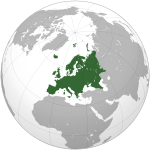
States with limited recognition Dependencies and other territories DenmarkFinlandUnited KingdomCategories:- Andorra
- European countries
- Catalan Countries
- Catalan-speaking countries
- Constitutional monarchies
- Liberal democracies
- Landlocked countries
- Member states of La Francophonie
- Principalities
- Prince-Bishoprics
- Pyrenees
- States and territories established in 1278
- Diarchies
- Member states of the United Nations
- Outline of Andorra
Wikimedia Foundation. 2010.

![Location of Andorra (green)in Europe (dark grey) — [Legend]](/pictures/enwiki/50/250px-Location_Andorra_Europe.png)
